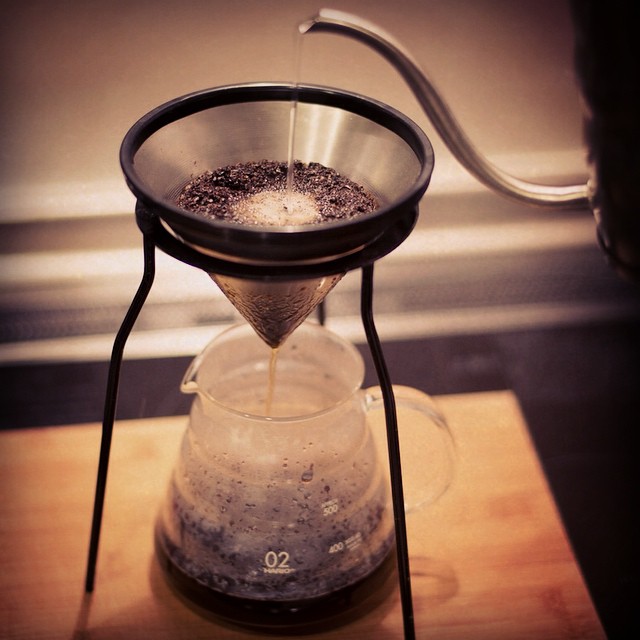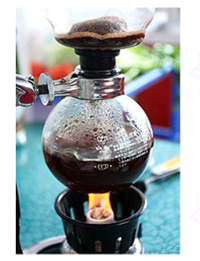Coffee brewing mode: several common mistakes and correct operation methods of hand-made coffee

▶ a good cup of hand-brewed coffee, you can taste the sour, fragrant, sweet and other different levels of detail changes, drink refreshing and burden-free, such a meticulous flavor change as long as the contact can not extricate itself.

Many friends of ▶ said, why can't they make a good cup of hand-made coffee when they have followed the steps? Now the editor exposes the common mistakes of making coffee from three angles!
Coffee beans

Error 1: degree of grinding
There are all kinds of bean grinders on the market, and a good bean grinder can ensure that the coffee powder is evenly ground. If the coffee powder is uneven and the fine powder is too much, it will make the coffee taste not "pure".
What is the suitable thickness of hand-brewed coffee beans?
The answer is: moderate grinding, the size of granulated sugar. If the coffee powder is too thick and the hot water flows too fast, it is difficult to extract the aromatic substances from the coffee. If the coffee powder is too fine, the filter is easy to clog, resulting in water and powder soaking time is too long, coffee will appear bitter, astringent taste.

Error 2: freshness
Many people choose ground coffee powder for convenience, or grind a lot at one time and put it in the refrigerator. In fact, "fresh grinding" is the first condition of good coffee, it ensures the taste of coffee. When the coffee is ground into powder, the oxidation rate of the coffee powder is accelerated, and the aroma begins to lose in 40 seconds. If the aroma of coffee powder is seriously lost, the flavor of natural coffee will disappear.

Error 3: cloth powder
After pouring the coffee powder into the drip filter cup, gently shake it to make it flat, this is a very easy to ignore step, or too hard, shake too many times, it is not advisable. The smoothness of the flour determines the uniformity of stewing and extraction of hand-made coffee, which directly leads to the taste of the coffee.
water

Error 1: water quality
If you care about taste, don't ignore the water used to make coffee. 98% of a cup of hand-brewed coffee is water, and the range of soluble matter (TDS) in water is preferably between 100 and 250ppm. It is not recommended to use pure water to make coffee. Coffee made with pure water often tastes dull and lacks a sense of hierarchy. But do not use mixed brand mineral water or mixed brand barreled water, once there is a strange smell in the water, it will be more obviously magnified and reflected in the coffee. (you can choose mineral water from famous brands such as Xafu.)

Error 2: water temperature
Water temperature is also an important indicator that affects the taste of coffee. Too high water temperature will make coffee bitter, while low water temperature will make coffee sour. Suggestion: deep roasted coffee beans are suitable for 80-85 degrees, while medium and shallow roasted coffee beans are suitable for extraction at about 90 degrees.
Error 3: current
Whether the aroma and hierarchy of coffee can be released heartily, the key lies in water injection. Common mistakes are:

a. The injected water column is too large and the direction of the water column is too tilted, which will cause the water to flush a hole in the side of the powder layer and run away directly from the filter paper, resulting in insufficient coffee extraction.
b. The water column is pulled too high, resulting in the flow of water to destroy the coffee powder, easy to inject bubbles, and uneven coffee extraction. It will also lead to too much water column and contact air area, and the water temperature will be affected, so the water column must be as close to the coffee as possible.
c. The water flow is unstable, sometimes large and small, sometimes dashing, sometimes ticking off, resulting in different degrees of soaking in different areas of coffee powder, and the taste of coffee will be affected.
Error 4: water quantity
As different people have different tastes, different requirements for shade are different. The concentration range of gold cup extraction is 1.15% Mo 1.35%, and the proportion of water used is about 1:13 to 15. Some people use very little water simply in pursuit of richness, but it doesn't taste good. On the contrary, some people expect to extract more substances with more water, but they do not realize that the later the extraction is, the lighter it is, and the final concentration is not enough.

Container
Error 1: filter paper
A good filter paper should be odorless and filtrate well. And many people are cheap to use inferior filter paper, which is very thin and easy to leak. Some filter paper filter speed is very slow, only water injection, but not dirty, which will inevitably lead to excessive coffee extraction, affecting the taste. Still wondering why I bought good coffee, but it didn't taste good.

Error 2: hand punch pot
As mentioned earlier, the flow of water has a critical impact on the quality of a cup of coffee, and the choice of the hand pot plays a vital role. What are the problems if you choose the wrong hand pot?

a. At the mouth of the pot, many hand pots have adopted a long mouth and a thin mouth, in order to make the flow easy to control, smooth and uninterrupted. Some students use low-quality hand flushing pots, or even directly use non-special hot water kettles, the water flow is difficult to uniform, and even flow down the bottom of the kettle mouth.
b. Thermometer, how to extract coffee at the best temperature? If there is a thermometer on the hand flushing pot, it will save time, effort and worry.
c. Heat preservation, remember to close the lid when hand flushing, the degree of temperature loss during extraction will be reduced, which can bring more stable water temperature.
Source: PT Coffee
Important Notice :
前街咖啡 FrontStreet Coffee has moved to new addredd:
FrontStreet Coffee Address: 315,Donghua East Road,GuangZhou
Tel:020 38364473
- Prev

Coffee brewing method: introduction to the skills and matters needing attention in the production of Japanese hand-made coffee
Japanese-style hand-brewed coffee seems simple, but in fact, a little carelessness in each step will lead to different tastes of coffee or subtle changes. there are a few points that need to master the basic principles of making Japanese-style hand-brewed coffee and some variables when making Japanese-style hand-made coffee. The following are some points that I have summed up after communicating with many well-known coffee teachers in Chongqing.
- Next

Coffee brewing method: Siphon pot of the correct operation of the order of introduction
1. Fill the water-hook the filter element: fill the lower pot with hot water to the "two cups" icon mark, put the filter element into the upper pot, pull the end of the chain with your hand, and gently hook it on the end of the glass tube. Be careful not to release the hook suddenly, so as not to damage the glass tube of the pot. 2. Ignite-Insert pot obliquely-Wait for big bubbles: Light alcohol lamp, insert upper pot obliquely, and let rubber edge press against lower pot
Related
- What is the meaning of lactic acid fermentation with coffee bean treatment?
- How to judge the state of foam by sound?
- How does the latte pull out the unicorn pattern? Come to get for a little trick to improve the flower pull!
- Will flower pulling affect the taste of the latte?
- Do you know the history of coffee?
- The difference between honey treatment and sun washing what is raisin honey treatment?
- What kind of milk can a novice use to make coffee foam to keep the foam longer? The correct method and skills of milking tutorial sharing
- Why do washed coffee beans taste sour? Flavor characteristics of washed Coffee
- Introduction to the skill of how to practice the size and height of water injection around the circle of hand-brewed coffee
- How do beginners practice coffee flower drawing from scratch?

